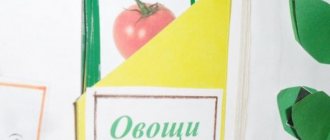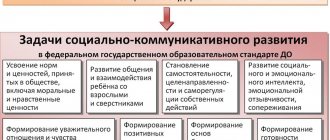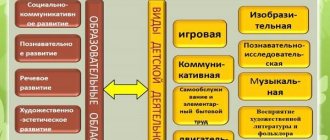Organization of studios and creative workshops in a preschool educational institution
Bibliographic description:
Aksenenko, S. V. Organization of the work of studios and creative workshops in a preschool educational institution / S. V. Aksenenko, O. I. Rusanova, L. V. Ryazantseva. — Text: direct // Questions of preschool pedagogy. - 2022. - No. 10 (37). — P. 15-17. — URL: https://moluch.ru/th/1/archive/183/5708/ (access date: 02/05/2022).
The article is devoted to the idea of creating creative workshops in kindergarten as part of the implementation of the federal state standard for preschool education (FSES DO). The experience of studios and creative workshops in preschool organizations with the involvement of preschoolers of different ages is analyzed. It has been proven that children's studios and creative workshops solve the problem of a student-oriented approach in a preschool educational organization.
Key words: studio, creative workshop, preschoolers, teachers.
Introduction. In modern pedagogical science, the problem of educating a creative personality is one of the most important. Many scientists have addressed the issues of creative development of children in various types of activities. Authors A. G. Gogoberidze, N. A. Korotkova, L. V. Lidak, N. S. Makhina, I. A. Mukhina, V. A. Radchenko, E. O. Smirnova and others paid attention to gaming activities as factor in the development of creativity and independence. N.A. Vetlugina, O.E. Zhirenko, T.S. Komarova, N.P. Sakulina, and others saw the creative development of children through artistic activity. Scientists O. V. Akulova, O. S. Gazman, B. S. Gershunsky, N. B. Krylova, S. A. Shmakov L. S. Furmina and others believed that theater workshops develop the creative abilities of children to the greatest extent.
Creativity is an activity aimed at obtaining something new, unique, and creative studios and creative workshops are forms of educational activity that allow children to show their initiative, as they are given the opportunity to satisfy their desires and needs in creativity.
Activities in creative studios and creative workshops are aimed at preserving the child’s creativity, providing assistance in realizing his abilities and capabilities, developing a creative personality, and partly, providing early professional guidance.
The main objectives of organizing group or studio work in kindergarten are: creating conditions for the creative potential of children, starting from an early age; satisfying the requests of parents (legal representatives) in the creative development of children; advanced training of teachers and the formation of new professional competencies in the field of artistic, aesthetic, cultural, educational, creative and environmental education of preschool children.
To implement the idea of creating creative workshops and studios, it is necessary to create conditions for an educational environment for the manifestation of the child’s personal qualities, the development of his potential, the search for himself through cognitive development and cultural values, and the formation of the child’s civic identity.
The study of the material on the research topic made it possible to formulate the purpose of the study - the creation of pedagogical conditions for organizing the work of studios and creative workshops in a preschool educational institution.
The object of the study is the organization of work of studios and creative workshops in a preschool educational institution.
The subject of the research is the pedagogical conditions for organizing the work of studios and creative workshops in a preschool educational institution.
The tasks have been set to achieve the goal: the creation of a special developmental subject-spatial environment, taking into account the educational potential of the group room space and materials, equipment and supplies to ensure the work of the studio and creative workshops; develop educational programs for studios and creative workshops, taking into account the use of inclusive education; take into account national and cultural conditions; create conditions for protecting and strengthening the physical and mental health, as well as the emotional well-being of children.
To solve these problems, activities have been developed that are included in the educational programs “Art Studio”, “Theater Studio”, creative workshop - appliqué, collage, modeling with plasticine and dough, quilling (weaving from twisted paper). Teachers work with preparatory group children in an art studio.
Research methods and subjects
Pupils of the junior and preparatory groups of the MKDOU Pavlovsk kindergarten No. 11 of the Pavlovsk municipal district of the Voronezh region took part in the study. The creation and organization of studios and creative workshops in a preschool educational institution began in 2022 and continues to this day.
The research methods used were creative tasks, which became more complex as they mastered techniques or gained experience in artistic or theatrical activities.
Research results and discussion
The results of the created pedagogical conditions for organizing the work of studios and creative workshops in a preschool educational institution are the works performed by children and teachers.
Rice. 1. Images of works completed by children together with teachers in creative workshops
Educational activities in creative workshops and studios are carried out according to the following algorithm: motivation due to the need for creative activity; discussion of the object to create; joint planning of upcoming activities with children; distribution of labor roles at the request of children depending on the type of activity (individual or group); joint activities of the teacher and children; analysis of performance results.
The algorithm of activities in an art studio and theatrical studio differs from creative workshops, since the leading role in the selection of material for the activity belongs to the teacher, music director or artist.
In both cases, children of the preparatory group are offered educational activities that involve the achievement of each child’s own holistic product, and children of younger groups perform the work together with the teacher. As a result, children in the younger group form a common product, for example, a rag doll. Each child prepared a piece of clothing for the doll, and if the child managed to tie a scarf or apron on his own, this is a great achievement for children of that age. The result of work in creative workshops is not only real skill, but the process of comprehending the truth and creating a creative product is important. However, educators monitor the achievements of preschoolers and monitoring is carried out through the observation method in younger groups and through the diagnosis of special abilities in preschoolers of the preparatory group. In younger groups, observation is carried out on the following parameters: perseverance; attention; development of small muscles of the fingers; hand mobility; motivation; development of interest; level of cognitive activity.
For preschoolers in the preparatory group, diagnostics of special abilities developed in creative workshops and studios is carried out according to the following parameters: perseverance; motivation; switchability and stability of interests; development of cognitive processes; communication skills; time orientation; introspection.
Conclusions: the initial idea of organizing the work of studios and creative workshops in a preschool educational institution is the position of creative transformation of the subject-developmental and entertainment-game environment, which leads to the development of the joint creative imagination of teachers and students. Such an environment is a way of establishing a connection with the artistic and aesthetic culture of the individual and forms part of the holistic process of education.
The organization of the work of studios and creative workshops in a preschool educational institution is based on the following components: communicative, as a factor in the socialization of the child; artistic and aesthetic; spiritual and moral (forms individual consciousness); physical (health culture); game; informative; labor; psychological (the child is the subject of activity).
Thus, organizing the work of studios and creative workshops in a preschool educational institution is a necessary condition for the overall development of the child.
Literature:
- Fink M., Bostelman Antge. Creative workshop in kindergarten. We draw, we sculpt, we design. Series “Anthology of Preschool Education”. National education, 2016–108 pp.
Work experience “Workshop as a form of working with children”
In my report I would like to highlight this form of working with children as a workshop. Using this statement, I would like to emphasize the importance of developing creative activity in children as a factor in overall personal development and growth. The essence of the modern personality-oriented process of preschool education is the process of the child’s accumulation of such specific subjective experience, which contains means and ways of interacting with the world and thanks to this expands the child’s opportunities to actively and creatively participate in this interaction and, moreover, encourages him to acquire his own experience. Creativity in the broad sense of the word is an activity aimed at obtaining something new and unique. Therefore, the main indicator of creativity is the novelty of the created product. The result of children's creative activity, as a rule, is not distinguished by objective novelty that is significant for science, culture or production. However, the products of children's activities are new to themselves and play a huge role for the development of the child. The basis of any creativity is imagination. The preschool age of a child is characterized by activation of the functions of imagination. And if the imagination is not specifically developed during this period, then a rapid decrease in the activity of this function occurs subsequently. Along with a decrease in the ability to fantasize, a person’s ability to think creatively decreases. However, fantasy should contribute to a better knowledge of the world, self-discovery and self-improvement of the individual, and not develop into passive daydreaming. Domestic psychologists have identified indicators with the help of which children’s creativity is “recognized.” What determines the novelty of creative solutions? The novelty of creative solutions is facilitated by a broad orientation in the material before presenting any tasks, organized by an adult as an independent child experimentation that acquires a cognitive character, and the formation of generalized methods of activity encourages children to “embed” previously assigned methods into new semantic contexts. And this, in turn, leads to the generation of both new methods, new images and new meanings based on cognitive and emotional experience. What does children's creative activity contribute to? It contributes to the formation of a universal ability to construct any activity that is significant for a child, be it visual, speech, play, etc., as the creation of integrity (drawing, text, plot) from different units, but using the same techniques. “Creative workshops” are one of the modern forms of educational activities that are very attractive to children. Children love everything bright and unusual; they like to sculpt, draw, cut, stick, experiment, and design. And where else can a child realize his ideas, if not in the “workshop”? There is everything here to create. “Creative workshop” is one of the new forms of direct educational, joint and independent activity for children. Creative workshops can be used in various areas of children’s activities: for example, theater workshops, in which children can create their own costumes and attributes for performances, can be used to develop children’s communicative, aesthetic, and artistic abilities. Workshops on developing communicative abilities using problem situations and reading fiction can be used in speech development activities. Art workshops give children the opportunity to independently choose materials, direction and technique for making a craft or drawing. Workshops of good deeds will help organize work on repairing books, toys, labor education, for example, helping a junior teacher. A local history workshop will help familiarize children with the sights of their hometown, teach them to appreciate their small homeland and be a patriot. Educational workshops have the ability to create layouts and diagrams that will help children master natural knowledge, such as the basics of mathematics, chemistry, and learn about the world around them, its structure and patterns. Thus, the use of the workshop as a form of work with children is possible in a wide variety of activities; a significant advantage of this form of work is the voluntary nature of work in the workshop, the ability of children to be independent, to make choices, to develop empathy and the ability to build joint activities with peers. The work is built in stages, where each stage roughly corresponds to an age period, starting from the middle group. Within the stages, work is carried out cyclically: “Working with paper”, “Working with natural materials”, “Working with threads and fabric”. The mastered content of one cycle is integrated into other cycles. When planning material, the principle of concentricity is observed, i.e. at each stage the content increases and becomes more complex. For example: if in middle age, when working with natural materials (stones), children only examine and paint them in different colors, then in the older group they already decorate the stones, and in the preparatory group they bring them to life with the help of details. Classes in the “workshop” help children develop the basic skills and abilities provided for by the program: the ability to hold a pencil, use a brush, scissors; pick up paints, etc. and contributes to the implementation of the tasks provided for in the educational field of “Artistic and Aesthetic Development”. Creativity plays a special role, which is important at all stages of the workshop’s activities. The incentive for associative thinking plays an important role. Associations in the workshop are used to actualize the personal experience of the participants, develop the work of imagination and thereby contribute to the development of the creative process of everyone’s activity. Working with associations can be used in any type of workshop: this is one of the main technological methods for individualizing work, even with a large number of participants. The peculiarity of the “workshop” is that the children themselves decide whether to participate today or not. Creativity cannot exist under pressure and violence. It should be free, bright and unique. Without parting with pencils, felt-tip pens, and paints, the child quietly learns to observe, compare, think, and fantasize. Materials for joint activities in the form of a workshop can be very diverse: paint, paper, scissors, glue, colored pencils, felt-tip pens, different types of paper, brushes of different sizes and purposes, napkins, “waste” material: candy wrappers, threads, all kinds of scraps for cutting and stickers The creative process is a real miracle. This is confirmed by observations of how children reveal their unique abilities and the joy that creation gives them. Here they begin to feel the benefits of creativity and believe that mistakes are just steps towards achieving a goal, and not an obstacle, both in creativity and in all aspects of their lives. It is better to instill in children: “In creativity there is no right way, there is no wrong way, there is only your own way.”
MAGAZINE Preschooler.RF
A CREATIVE WORKSHOP IS AS ONE OF THE MOST EFFECTIVE FORMS OF WORKING WITH THE FAMILY IN A PRESENTER.Educator German Galina Petrovna South-Eastern Department of the Moscow Region and NSO Kindergarten "Solnyshko" GBOU secondary school village. Alekseevka m. Alekseevsky Samara region
Children should live in a world of beauty, games, fairy tales, music, drawing, fantasy, and creativity. (V. A. Sukhomlinsky)
Kindergarten Solnyshko " Since December 2017, Alekseevka has been a pilot site for testing the “Mosaic” of the educational complex “Mosaic Park” .
In accordance with the Federal Law dated December 29, 2012 No. 273-FZ “On Education in the Russian Federation” , Federal State Educational Standards for Education, approved by order of the Ministry of Education and Science of Russia dated October 17, 2013 No. 1155, parents have a priority right to educate and raise children over all by other persons.
During the implementation of the “Mosaic” of the educational complex “Mosaic Park”, teachers of the “Solnyshko” used and introduced various forms of work with families.
The most successfully and effectively implemented form of work was the “Creative Workshop” .
The purpose of the “Creative Workshop” :
- Involving parents in the educational process.
- Expand the ideas of parents of pupils about creative activity, increasing their competence.
- Development of parent-child relationships based on joint activities.
- Development of the creative union of parents (legal representatives) and the child, their close communication, where the children’s talents are revealed, the need to participate in the upbringing of the child together with the preschool educational institution.
Tasks:
- Promote the unity of the child-parent team and the team of teachers.
- Development of creative abilities of children and parents.
- Development of the emotional sphere in children.
Meetings in the “Creative Workshop” were held once a month. First, master classes for children and parents were shown by the group’s teachers. Further, as the meetings were held, parents also joined in the master classes and began to share their knowledge and creative experience with each other.
The following master classes were held: “Travyanchik” , where children, together with their parents and teachers, participated in experimental activities on germinating wheat seeds. “Do it yourself paper” master class , children and parents made an environmentally friendly product - paper from napkins and water, then they made beautiful paintings and gave them to each other. The master class “Wine weaving” was conducted by the parent Pavlenko A.V., where, in the course of creative activity, they talked about the ancient craft of wicker weaving. Children, parents and teachers wove baskets from willow branches, gradually learning the technology of preparing vines for making baskets.
The master class “Do-It-Yourself Spoon Theatre” by parent S.A. Nikolaeva, where children, parents, and teachers participated in making the theater and participated in theatrical activities with the children. “Drawing with Salt” and “Drawing with Crumpled Paper” master classes . “Magic Mat” master class, children learned about working with paper using the techniques of cutting and rolling paper.
The creative workshop “Visiting Santa Claus” , where parents and children decorated the group with paper crafts using the “pull-out” and made a “Christmas wreath” .
One of the cycles of our creative workshop was “Meetings at the kindergarten site” . Parents, together with children and teachers, took part in creating a developmental environment in the kindergarten area: they created a “Bird Canteen” in the style of wooden architecture, wove bird feeders from vines, decorated a flower garden and took part in the “Plant a Flower - Give Tenderness!” . In the winter, we took part in building a slide together with the children, which contributed to a healthy lifestyle for the children.
Thus, a creative workshop, as one of the forms of interaction between a kindergarten and a family, helps not only to establish emotional contact with parents, improve child-parent relationships based on joint creative activity, but also to become a kind of club for children, parents and teachers.
Literature:
- Babaeva T.I., Rimashevskaya L.S. “How to develop relationships and cooperation of preschoolers in kindergarten. Game situations, games, sketches: textbook. – method. allowance" . – St. Petersburg: Publishing House “Childhood - PRESS” , 2017.
- Davydova O. I., Mayer A. A., Bogoslovets L. G. Projects in working with the family. Toolkit. – M.: TC Sfera, 2022. – 128 p.
- Introduction of Federal State Educational Standards for Preschool Education into the practice of preschool educational organizations / comp. N.V. Nishcheva. – St. Petersburg: LLC “Childhood – Press” , 2014.
- Order of the Ministry of Education and Science of the Russian Federation dated October 17, 2013. No. 1155 “On approval of the federal state educational standard for preschool education .
| Next > |
Pedagogical opportunities of a creative workshop in nurturing independence in children of senior preschool age
The introduction of the Federal State Educational Standard for Preschool Education makes it possible to organize joint activities with children and use both traditional and non-traditional forms of working with children [1].
Among the innovative forms of organizing educational activities within the framework of solving the problem of integrating different types of artistic and aesthetic activities of children, design is distinguished - GOST
others, parent-child creative clubs, creative workshops, literary, art and music salons, which makes the educational process more interesting and memorable for children.
A creative workshop is one of the new forms of direct educational, joint and independent activities of children in preschool educational institutions.
In order to highlight the essence of a creative workshop, we examined the following concepts: “workshop”, “creative workshop”, “teaching workshop”
The very concept of “workshop” came to pedagogy from the sphere of creativity, initially implying a place where something new is created, something that has not existed until today.
The pedagogical workshop originated in France in the 30s of the twentieth century. Its developers are psychologists such as Paul Langevin, Henri Vallon, Jean Piaget and others. Pedagogical workshops are a form of organizing the educational process that creates a creative atmosphere, psychological comfort, promotes personal growth, and gives the joy of co-creation.
In our country, workshop technology was developed in the works of G.S. Altshuller, I.P. Volkova, I.P. Ivanov as a technology of creative developmental education, which became the theoretical basis for the creation of original schools.
The workshops are varied in their themes and content, for example: handicrafts, introduction to folk crafts (“Visiting Folk Crafts”), viewing educational presentations, designing an art gallery, book corner or library (“Printing Workshop”, “Visiting a Fairy Tale” "), games and collecting[2].
The main ideas of the workshops are expressed in the following provisions:
The individual himself is capable of building his knowledge and actively and creatively using it in life.
A citizen is understood as an “independent, creative, socially responsible and constructively armed” person capable of having a positive impact on his life and the world around him.
Every person (child) - “Everyone is capable!” The slogan “Everyone is capable” allows for early diagnosis of giftedness, creating optimal conditions for talented children for the development and formation of their personality.
The beginning of a workshop is usually a task around a word, melody, drawing, object, memory. This is followed by working with a wide variety of materials: words, sound, color, natural materials, diagrams and models. It is mandatory to include children in reflective activities: analysis of their feelings, thoughts, views (“What were you surprised by? What did you learn? What made you happy?” etc.).
Classes in the creative workshop help children develop the basic skills and abilities provided for by the program: the ability to hold a pencil, use a brush, scissors; pick up paints, etc. and contributes to the implementation of the tasks provided for in the educational field of “Artistic and Aesthetic Development”. GEF DO in accordance with clause 2.6. The educational field “Artistic and aesthetic development” involves the implementation of independent creative activities of children (visual, constructive-model, musical, etc.)
Thus, a creative workshop is a repository of cultural values that characterize various aspects of human activity. The use of a workshop as a form of work with children is possible in a variety of types of productive activities; a significant advantage of this form of work is the voluntary nature of work in the workshop, the ability of children to be independent, to make choices, to develop empathy and the ability to build joint activities with peers. It is very important that while working in a creative workshop, the child shows interest, activity, independence, fulfills the teacher’s tasks with interest and rejoices in his successes.
Bibliography
Federal state educational standard for preschool education: approved by order of the Ministry of Education and Science of the Russian Federation dated October 17, No. 1155. – M., 2013 [Electronic resource].URL: (date of access: 09/05/2017).
Babaeva T.I., Gogoberidze A.G., Solntseva O.V. and others. Educational program “Childhood” // Navigator of educational programs for preschool education. – PUBLISHING HOUSE “Childhood – Press” LLC, 2014 [Electronic resource]. System. Requirements: Adobe Acrobat Reader. – URL: (access date: 04/02/2018).
Petrenko G.A. A creative workshop is a stimulus for the self-development of a child’s personality. [Electronic resource].URL: (date of access: 04/05/2018).




